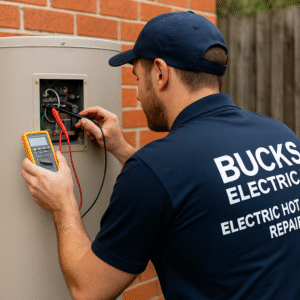Electrical panels are the heart of a home’s electrical system, distributing power safely and efficiently to every circuit. Over time, electrical panels can become outdated, unable to handle modern electrical demands, or even pose safety risks. For homeowners, understanding the electrical panel upgrade cost is critical to budgeting effectively while ensuring safety and efficiency.
In this article, we’ll explore the factors that determine the electrical panel upgrade cost, why upgrading is important, and how to plan a budget-friendly upgrade without compromising safety.
Why Upgrade Your Electrical Panel?
Before discussing the electrical panel upgrade cost, it’s important to understand why an upgrade may be necessary:
-
Increased Power Capacity: Older panels often cannot support modern appliances, HVAC systems, and smart home devices.
-
Enhanced Safety: New panels feature updated breakers, proper grounding, and surge protection to reduce the risk of electrical fires and shocks.
-
Compliance with Electrical Codes: Upgrading ensures your system meets local building codes and safety standards.
-
Future-Proofing: Modern panels can accommodate additional circuits and higher power demands, reducing the need for frequent upgrades.
-
Increased Home Value: Homes with updated electrical systems are more attractive to buyers and often fetch a higher market price.
Knowing these benefits helps justify the electrical panel upgrade cost as an investment in both safety and efficiency.
Factors Affecting Electrical Panel Upgrade Cost
Several factors influence the total electrical panel upgrade cost, including panel size, labor, materials, location, and additional work required.
1. Panel Size
Panel size, measured in amperage, is a major determinant of cost:
-
100-amp panels: Typically found in older homes; suitable for basic electrical needs.
-
150-200 amp panels: Ideal for modern homes with multiple appliances, EV chargers, and smart devices.
-
400-amp panels: Used in large homes or homes with heavy electrical loads.
Larger panels require more breakers, wiring, and labor, increasing the overall electrical panel upgrade cost.
2. Type of Panel
The type of panel chosen can also impact cost:
-
Standard Load Centers: Affordable and sufficient for most homes.
-
Main Breaker Panels: Add a main shut-off switch for enhanced safety.
-
Main Lug Panels: Often more cost-effective but require a separate disconnect.
-
Smart Panels: Include remote monitoring, energy management, and surge protection, often at a higher price.
Selecting the appropriate panel type affects both material costs and installation labor, influencing the electrical panel upgrade cost.
3. Labor Costs
Labor accounts for a significant portion of the electrical panel upgrade cost. Key considerations include:
-
Hourly Rates: Electricians typically charge $50–$100 per hour, depending on location and experience.
-
Project Complexity: Panels requiring additional wiring, circuit relocation, or relocation of the panel itself take longer to install.
-
Permit Handling: Licensed electricians manage permits and inspections, which may add to labor costs.
4. Material Costs
Material costs include the panel itself, breakers, wiring, connectors, and safety components:
-
Panel Size and Brand: Larger panels or premium brands increase costs.
-
Wiring Upgrades: Homes with outdated or damaged wiring may require replacement.
-
Safety Features: Surge protectors, grounding rods, and modern breakers add to the material cost.
High-quality materials may increase the electrical panel upgrade cost but improve safety and reliability.
5. Home Location and Accessibility
The location of your home and the electrical panel can affect cost:
-
Urban vs. Rural: Labor rates and permit fees vary by region.
-
Panel Accessibility: Panels in cramped spaces or basements may require extra work for safe installation.
-
Local Codes: Municipal regulations can influence cost through permit and inspection fees.
These factors contribute to variations in the electrical panel upgrade cost from one home to another.
6. Additional Electrical Work
Upgrading a panel sometimes requires extra work, impacting overall cost:
-
Rewiring Circuits: Updating old or insufficient wiring to meet modern standards.
-
Adding Dedicated Circuits: High-demand devices like EV chargers or ovens require separate circuits.
-
Panel Relocation: Moving the panel to a more accessible location can add labor and materials costs.
Accounting for these additional tasks helps homeowners budget accurately for the electrical panel upgrade cost.
7. Permit and Inspection Fees
Most jurisdictions require permits for electrical panel upgrades to ensure safety:
-
Permit Costs: Typically range from $50 to $500 depending on the city or county.
-
Inspections: Ensure work meets local codes and safety standards.
Permit and inspection fees are included in the total electrical panel upgrade cost and are essential for compliance.
8. Age and Condition of Home’s Electrical System
Older homes often require more extensive work:
-
Outdated Panels: May need full replacement rather than partial upgrades.
-
Aluminum Wiring: Homes with older aluminum wiring may require updates.
-
Grounding and Safety: Older homes may lack proper grounding or surge protection, adding to cost.
Newer homes often have updated wiring and panels, which reduces labor and materials expenses, affecting the electrical panel upgrade cost.
Average Electrical Panel Upgrade Cost
The electrical panel upgrade cost varies widely depending on size, materials, labor, and location:
-
100-amp panel: $1,000–$1,500
-
150-amp panel: $1,200–$2,000
-
200-amp panel: $1,500–$3,000
-
400-amp panel: $2,500–$5,000+
These ranges include labor, materials, and permits but can fluctuate based on additional work like rewiring or panel relocation.
Tips for Budgeting Your Upgrade
-
Get Multiple Quotes: Compare estimates from licensed electricians to find competitive pricing.
-
Plan for the Future: Include extra capacity for smart devices, EV chargers, or new appliances.
-
Bundle Work: Combine panel upgrades with other electrical improvements to save on labor costs.
-
Prioritize Safety: Avoid cheap materials or unlicensed labor to reduce long-term risks.
-
Research Local Costs: Knowing your area’s labor rates and permit fees helps create a realistic budget.
Benefits That Justify the Electrical Panel Upgrade Cost
While the electrical panel upgrade cost may seem significant, the benefits often outweigh the initial investment:
-
Safety: Reduces fire risk and prevents electrical overloads.
-
Energy Efficiency: Supports energy-efficient appliances and smart home devices.
-
Convenience: Allows you to use multiple devices simultaneously without tripping breakers.
-
Home Value: Enhances the resale value of your property.
Investing in a properly planned upgrade ensures long-term reliability and peace of mind.
Conclusion
Understanding the electrical panel upgrade cost is essential for homeowners looking to improve safety, efficiency, and functionality in their homes. Factors such as panel size, type, labor, materials, home location, additional electrical work, and permits all influence the total cost.
By planning ahead, consulting licensed electricians, and budgeting appropriately, homeowners can perform a safe, efficient, and code-compliant upgrade that supports current and future electrical needs.
For professional guidance, installation, and safe, reliable service, partnering with Madison Electric Company ensures that your electrical panel upgrade cost is optimized while delivering high-quality work, safety, and long-term efficiency for your home’s electrical system.

